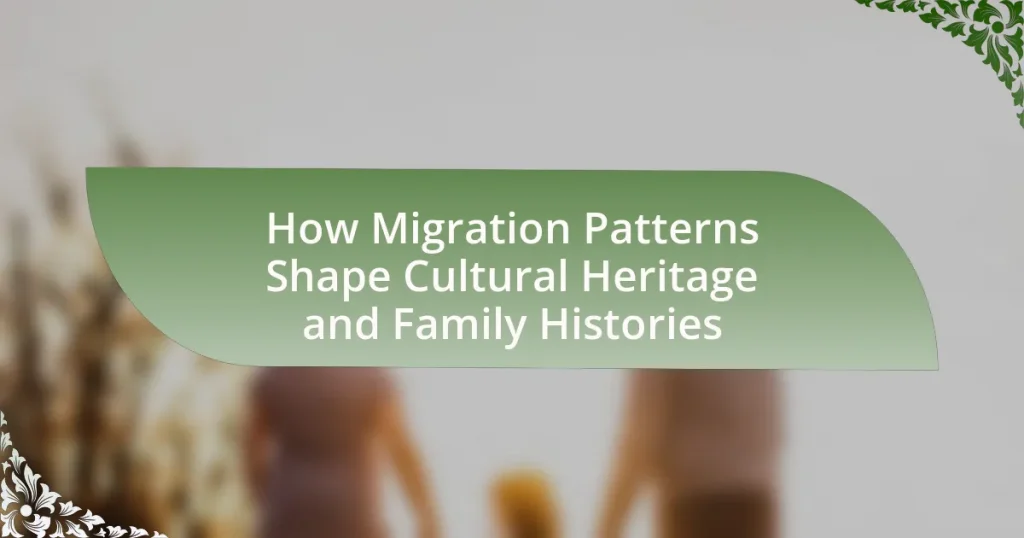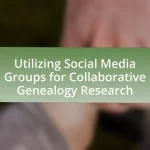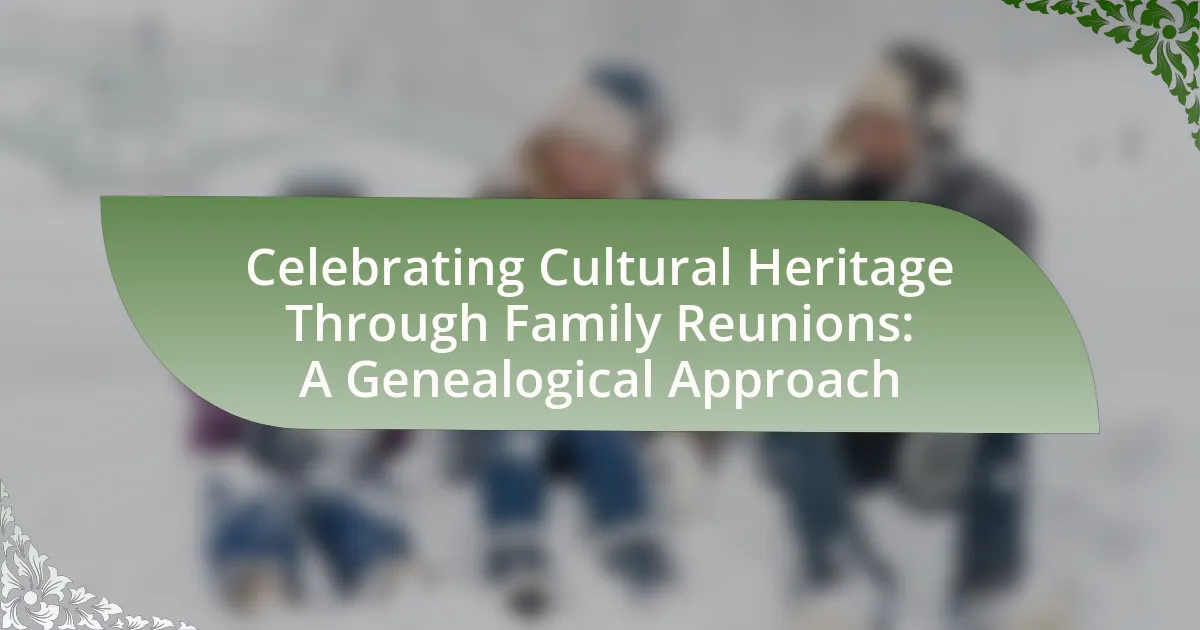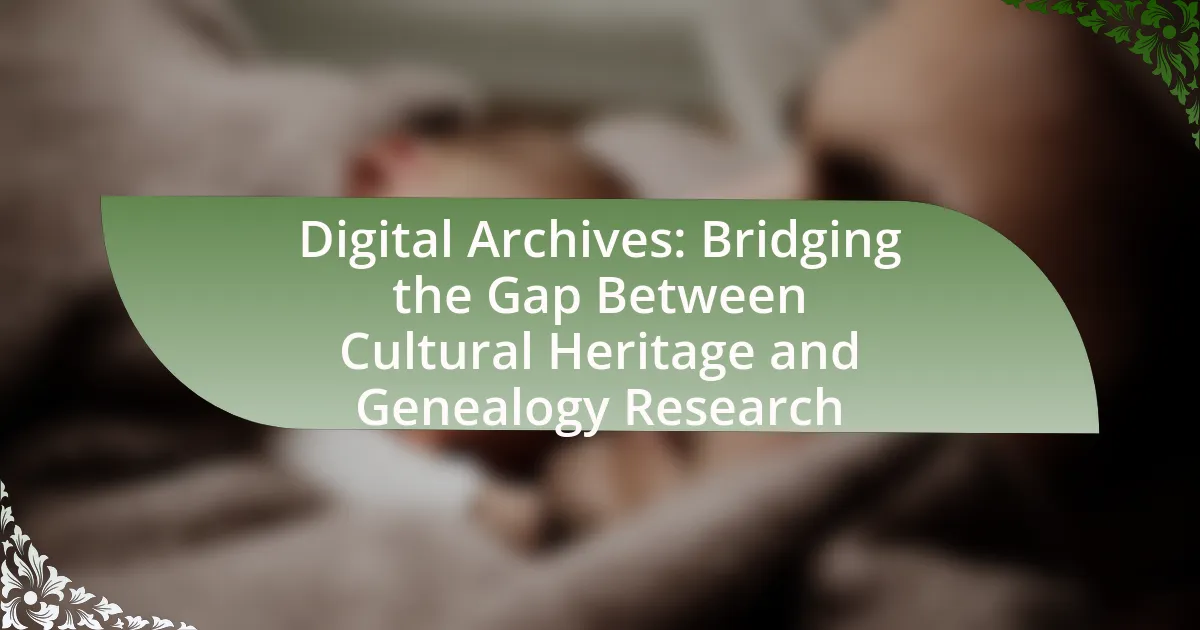Migration patterns play a crucial role in shaping cultural heritage and family histories by facilitating the exchange and blending of traditions, languages, and customs among diverse populations. Key factors driving migration include economic opportunities, political instability, environmental changes, and social networks, all of which influence individuals’ decisions to relocate. The article explores how migration contributes to cultural exchange, the impacts of cultural blending on communities, and the ways migrants preserve their cultural identities. It also examines the long-term effects of migration on family structures, narratives, and the resources available for exploring family histories related to migration. Through this analysis, the article highlights the complex relationship between migration, cultural evolution, and familial connections.
How do migration patterns influence cultural heritage?
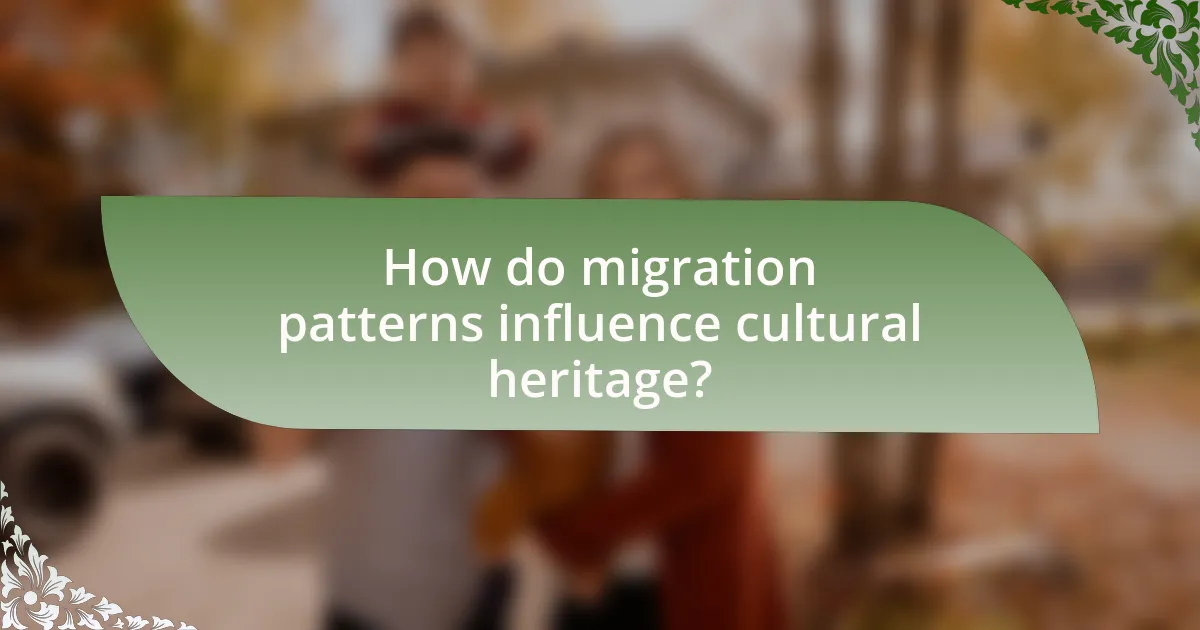
Migration patterns significantly influence cultural heritage by facilitating the exchange and blending of traditions, languages, and customs among diverse populations. When groups migrate, they bring their cultural practices with them, which can lead to the creation of hybrid cultures. For example, the migration of Italians to the United States in the late 19th and early 20th centuries resulted in the establishment of Italian-American communities that preserved and adapted their culinary traditions, festivals, and religious practices, thereby enriching the cultural landscape of the U.S. This blending often results in new cultural expressions that reflect both the original and the host cultures, demonstrating how migration acts as a catalyst for cultural evolution.
What are the key factors that drive migration patterns?
The key factors that drive migration patterns include economic opportunities, political instability, environmental changes, and social networks. Economic opportunities often motivate individuals to move in search of better jobs and living conditions, as evidenced by the significant migration from rural to urban areas in developing countries for employment. Political instability, such as conflict or persecution, forces people to flee their home countries, illustrated by the Syrian refugee crisis, where millions have sought safety in other nations. Environmental changes, including climate change and natural disasters, also compel migration, with studies indicating that rising sea levels and extreme weather events displace communities. Lastly, social networks play a crucial role, as established immigrant communities provide support and resources for newcomers, facilitating further migration.
How do economic conditions affect migration decisions?
Economic conditions significantly influence migration decisions by affecting individuals’ and families’ perceived opportunities and quality of life. When economic conditions are poor, such as high unemployment rates or low wages in a home country, individuals are more likely to seek better opportunities abroad. For instance, the World Bank reported that in 2020, over 1.7 billion people lived in extreme poverty, prompting many to migrate in search of improved economic prospects. Conversely, favorable economic conditions in destination countries, characterized by job availability and higher living standards, attract migrants seeking to enhance their financial stability. This relationship between economic conditions and migration is further supported by studies indicating that economic downturns in one region often lead to increased migration flows to areas with stronger economies.
What role do political factors play in shaping migration trends?
Political factors significantly influence migration trends by determining the legal frameworks, policies, and conditions that either facilitate or restrict movement across borders. For instance, changes in immigration laws, such as the introduction of more stringent visa requirements or the establishment of refugee protection policies, can directly impact the flow of migrants. Historical examples include the U.S. Immigration Act of 1924, which severely limited immigration from certain countries, leading to a dramatic decrease in migration from those regions. Additionally, political instability, such as civil wars or oppressive regimes, often forces individuals to flee their home countries, as seen in the Syrian refugee crisis, where millions have migrated due to conflict and persecution. Thus, political factors are crucial in shaping both the volume and direction of migration trends.
How does migration contribute to cultural exchange?
Migration contributes to cultural exchange by facilitating the movement of people who bring diverse traditions, languages, and practices to new environments. This interaction leads to the blending of cultures, as migrants share their customs and adopt elements from the host society. For instance, the migration of Italians to the United States in the late 19th and early 20th centuries introduced Italian cuisine, which has since become a staple in American culture. Additionally, studies show that cities with high levels of immigration, such as New York and Los Angeles, exhibit rich cultural diversity, showcasing festivals, art, and music from various backgrounds, thereby enriching the local culture.
What are the impacts of cultural blending on communities?
Cultural blending significantly impacts communities by fostering diversity, enhancing social cohesion, and promoting innovation. When different cultural groups interact, they share traditions, languages, and practices, which can lead to a richer community identity. For instance, cities like New York and London exemplify how cultural blending creates vibrant neighborhoods where various cuisines, festivals, and art forms coexist, enriching the local culture. Research indicates that communities with high levels of cultural diversity often experience increased creativity and economic growth, as diverse perspectives contribute to problem-solving and innovation. This blending can also lead to challenges, such as cultural clashes or identity crises, but overall, the positive impacts on community resilience and adaptability are well-documented.
How do migrants preserve their cultural identities in new environments?
Migrants preserve their cultural identities in new environments through various means such as maintaining language, participating in cultural practices, and forming community networks. Language serves as a primary vehicle for cultural transmission, allowing migrants to communicate their heritage and values to younger generations. Engaging in traditional customs, festivals, and rituals reinforces cultural ties and fosters a sense of belonging. Additionally, community networks, including cultural organizations and social groups, provide support and a shared space for cultural expression, enabling migrants to connect with others who share similar backgrounds. These strategies collectively help migrants navigate their new surroundings while retaining their cultural identities.
In what ways do migration patterns affect family histories?
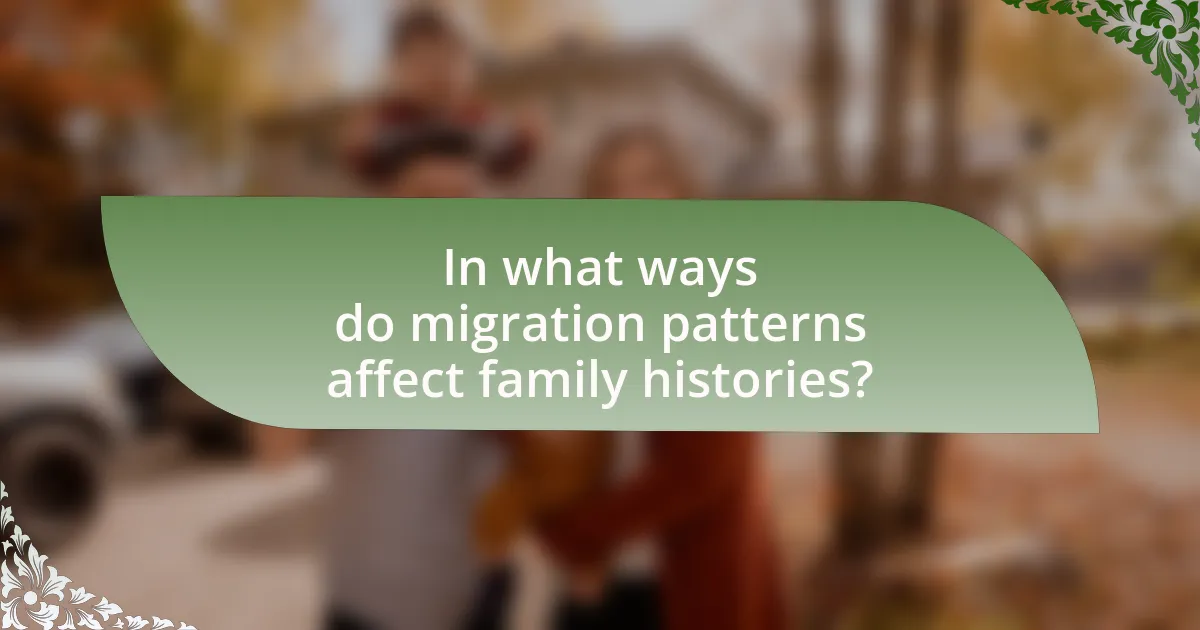
Migration patterns significantly influence family histories by altering social structures, cultural identities, and genealogical connections. When families migrate, they often experience shifts in their cultural practices, which can lead to the blending of traditions or the loss of ancestral customs. For example, the Great Migration in the United States saw African American families move from the rural South to urban centers in the North, resulting in new cultural expressions like jazz and blues that shaped their collective identity. Additionally, migration can create complex family trees, as individuals may marry across cultural lines or establish new familial ties in different regions, complicating genealogical research. Historical records often reflect these changes, showing how migration routes and settlement patterns have led to diverse family narratives and identities over generations.
How do migration experiences shape family narratives?
Migration experiences shape family narratives by influencing identity, values, and traditions passed down through generations. Families often recount stories of their migration journey, which can highlight resilience, adaptation, and cultural preservation. For instance, research indicates that narratives surrounding migration can foster a sense of belonging and continuity, as families integrate their past experiences into their current identity. Studies show that children of migrants often learn about their heritage through these stories, reinforcing cultural ties and shaping their worldview. This process is evident in various communities, where oral histories and shared experiences become central to family identity, illustrating the profound impact of migration on familial storytelling.
What stories emerge from intergenerational migration experiences?
Intergenerational migration experiences often reveal stories of resilience, adaptation, and cultural preservation. These narratives highlight how families navigate the challenges of relocation, maintaining their cultural identity while integrating into new societies. For instance, research shows that children of migrants frequently experience a blend of their parents’ cultural heritage and the dominant culture of their new environment, leading to unique hybrid identities. Studies, such as those conducted by the Pew Research Center, indicate that 60% of second-generation immigrants feel a strong connection to their ancestral culture, illustrating the ongoing influence of migration on family histories and cultural heritage.
How do family structures change due to migration?
Migration alters family structures by often leading to the separation of family members and the reconfiguration of roles within the family unit. When individuals migrate for work or better opportunities, they may leave behind spouses, children, or elderly relatives, resulting in a shift from traditional family dynamics to more nuclear or single-parent arrangements. This separation can create new family roles, such as increased responsibilities for children or extended family members who remain in the home country.
Research indicates that in many cases, remittances sent back home by migrant workers can support family members left behind, changing the economic structure of the family and sometimes leading to a dependency on these financial contributions. Additionally, migration can lead to the blending of cultures, as families adapt to new environments, which may influence parenting styles, values, and family interactions. Studies show that these changes can have long-term effects on family cohesion and identity, as families navigate the complexities of living across borders.
What challenges do families face during migration?
Families face numerous challenges during migration, including economic instability, legal barriers, and social integration issues. Economic instability arises as families often leave behind stable jobs and must navigate new job markets, which can lead to financial insecurity. Legal barriers, such as visa restrictions and immigration laws, complicate the migration process and can result in families facing deportation or separation. Social integration issues manifest as families struggle to adapt to new cultures, languages, and social norms, which can lead to isolation and mental health challenges. These challenges are supported by research indicating that migrant families frequently experience heightened stress and anxiety due to these factors, impacting their overall well-being and cultural adaptation.
How do language barriers impact family communication?
Language barriers significantly hinder family communication by creating misunderstandings and emotional distance among family members. When individuals within a family do not share a common language, it becomes challenging to convey thoughts, feelings, and important information, leading to frustration and isolation. Research indicates that families with language barriers often experience increased conflict and decreased cohesion, as effective communication is essential for resolving disputes and fostering relationships. For instance, a study published in the Journal of Family Communication found that language differences can lead to feelings of alienation, particularly among immigrant families, where children may become translators for their parents, placing undue stress on them and affecting family dynamics.
What are the emotional effects of separation on families?
Separation has significant emotional effects on families, often leading to feelings of grief, anxiety, and disconnection. Research indicates that family members may experience heightened stress levels due to the loss of daily interactions and support systems, which can exacerbate feelings of loneliness and isolation. A study published in the Journal of Family Psychology found that children of separated families often show increased behavioral problems and emotional distress, highlighting the profound impact of separation on familial relationships. Additionally, parents may struggle with guilt and worry about their children’s well-being, further complicating their emotional state. These emotional challenges can persist over time, affecting family dynamics and individual mental health.
What are the long-term effects of migration on cultural heritage and family histories?
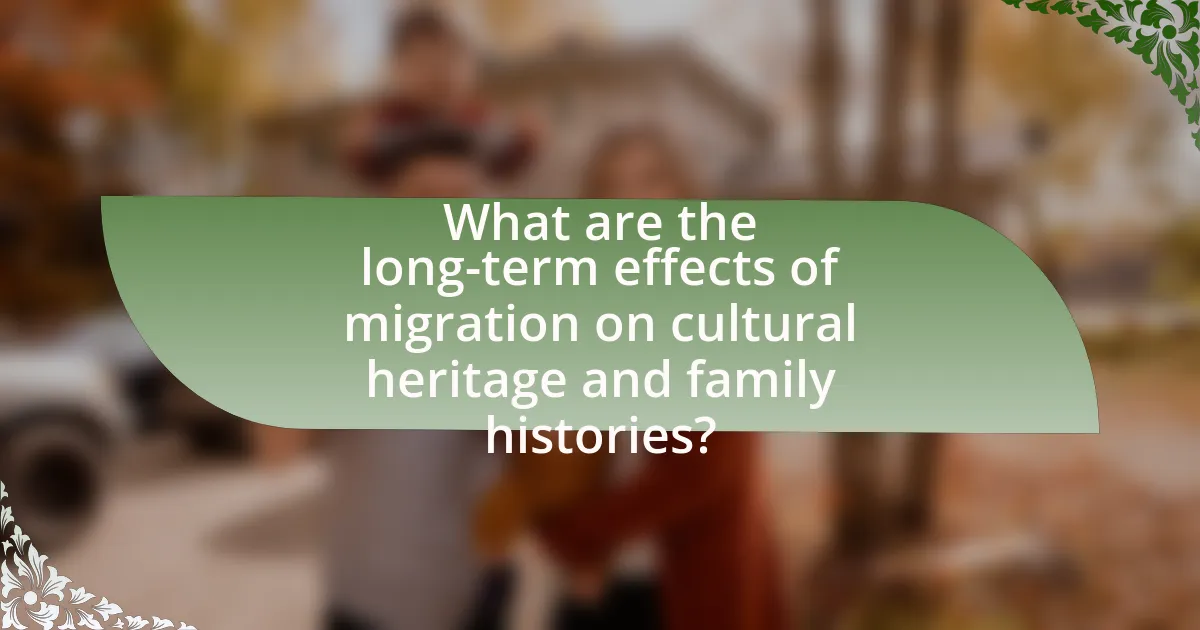
The long-term effects of migration on cultural heritage and family histories include the blending and transformation of cultural practices, languages, and traditions, as well as the creation of new identities. Migration often leads to the preservation of certain cultural elements while simultaneously introducing new influences, resulting in hybrid cultures. For example, the migration of Italians to the United States in the late 19th and early 20th centuries led to the establishment of Italian-American communities that maintained traditional customs, such as specific culinary practices, while also adopting aspects of American culture. This process can alter family histories, as narratives and values are reshaped through the experiences of migration, leading to a redefinition of familial ties and cultural legacies. Studies have shown that these changes can impact social cohesion within migrant communities and influence intergenerational relationships, as younger generations navigate their dual heritage.
How do second and third generations perceive their cultural heritage?
Second and third generations often perceive their cultural heritage as a blend of their ancestral traditions and the contemporary culture in which they are raised. This duality can lead to a sense of pride in their heritage while also creating challenges in identity formation. Research indicates that these generations may engage with their cultural heritage through family stories, celebrations, and community events, which serve to reinforce their connection to their roots. For instance, a study by the Pew Research Center found that 67% of second-generation immigrants feel a strong connection to their family’s cultural background, highlighting the importance of cultural heritage in shaping their identities.
What role does education play in cultural identity among descendants?
Education plays a crucial role in shaping cultural identity among descendants by providing knowledge and understanding of their heritage. Through educational curricula that include cultural history, language, and traditions, descendants can connect with their ancestral roots, fostering a sense of belonging and identity. Studies have shown that when educational systems incorporate multicultural perspectives, students from diverse backgrounds exhibit stronger cultural pride and awareness. For instance, research by the American Psychological Association indicates that culturally relevant education enhances self-esteem and identity among minority students, reinforcing the importance of education in cultural identity formation.
How do community organizations support cultural heritage preservation?
Community organizations support cultural heritage preservation by actively engaging in initiatives that document, celebrate, and promote local traditions and histories. These organizations often conduct workshops, cultural events, and educational programs that raise awareness about the significance of cultural heritage, thereby fostering community pride and identity. For instance, organizations may collaborate with local artists and historians to create exhibitions that showcase traditional crafts or storytelling sessions that highlight ancestral narratives. Additionally, they may advocate for policies that protect historical sites and support funding for preservation projects, ensuring that cultural practices are maintained for future generations.
What strategies can families use to maintain their cultural heritage?
Families can maintain their cultural heritage by actively engaging in traditions, language preservation, and community involvement. Engaging in traditions such as celebrating cultural festivals and preparing traditional foods reinforces cultural identity and fosters a sense of belonging. Language preservation through speaking the native language at home and teaching it to younger generations ensures that cultural nuances and values are transmitted. Community involvement, such as participating in cultural organizations or events, strengthens connections with others who share similar backgrounds, creating a supportive environment for cultural expression. These strategies are supported by research indicating that active participation in cultural practices significantly enhances cultural continuity among immigrant families.
How can storytelling be used to pass down family histories?
Storytelling can be used to pass down family histories by creating a narrative that connects generations through shared experiences and values. This method allows families to preserve their unique cultural heritage, as stories often include significant events, traditions, and lessons learned from ancestors. Research indicates that oral traditions, a form of storytelling, have been crucial in maintaining cultural identity among migrant communities, as they help individuals understand their roots and the journeys of their forebears. For example, studies show that storytelling fosters emotional connections and reinforces familial bonds, making it an effective tool for transmitting knowledge and cultural practices across generations.
What practices help families stay connected to their roots?
Practices that help families stay connected to their roots include storytelling, cultural celebrations, and maintaining family traditions. Storytelling allows families to pass down histories and values, reinforcing a sense of identity and belonging. Cultural celebrations, such as festivals and holidays, provide opportunities for families to engage with their heritage and share it with younger generations. Maintaining family traditions, such as specific recipes or rituals, fosters continuity and connection to ancestral practices. These practices are supported by research indicating that cultural continuity enhances familial bonds and identity, particularly in immigrant families navigating new environments.
What resources are available for exploring family histories related to migration?
Resources available for exploring family histories related to migration include genealogical databases, immigration records, and historical archives. Genealogical databases such as Ancestry.com and FamilySearch.org provide access to a wide range of records, including census data, birth and death certificates, and immigration documents. Immigration records, often found in national archives or specific immigration centers, detail the arrival and naturalization of immigrants, offering insights into family origins and migration patterns. Historical archives, including local libraries and state historical societies, often house unique collections of letters, diaries, and photographs that can illuminate personal migration stories. These resources collectively enable individuals to trace their ancestry and understand the impact of migration on their family histories.
How can genealogical research aid in understanding family migration patterns?
Genealogical research aids in understanding family migration patterns by providing detailed records of ancestors’ movements, including birthplaces, marriage locations, and death certificates. These records reveal historical migration trends, such as the Great Migration in the United States, where millions moved from rural areas to cities between 1916 and 1970, significantly impacting family structures and cultural identities. Additionally, census data and immigration records can illustrate shifts in population demographics, helping to trace how families adapted to new environments and maintained cultural practices. This information is crucial for comprehending the broader context of migration and its effects on cultural heritage and family histories.
What online tools and databases are useful for tracing cultural heritage?
Online tools and databases useful for tracing cultural heritage include Ancestry.com, FamilySearch.org, and MyHeritage. Ancestry.com provides access to a vast collection of historical records, including census data and immigration records, which can help individuals trace their lineage and understand migration patterns. FamilySearch.org, operated by The Church of Jesus Christ of Latter-day Saints, offers free access to genealogical records and resources, facilitating research into family histories and cultural backgrounds. MyHeritage combines DNA testing with historical records, allowing users to explore their ancestry and connect with relatives globally. These platforms collectively support the exploration of cultural heritage by providing essential data and tools for genealogical research.
